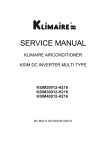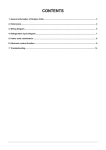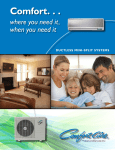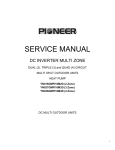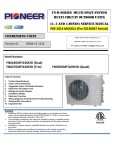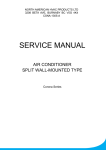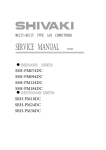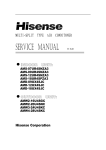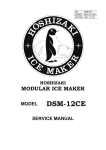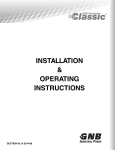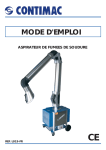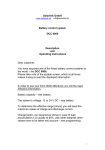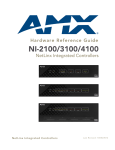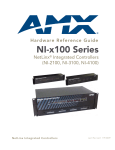Download Inverter Flex Multi-Zone Ductless Mini Split
Transcript
SERVICE MANUAL Inverter Flex Multi-Zone Ductless Mini Split Outdoor Section A-VMH18DC-1 A-VMH27TC-1 A-VMH36QC-1 Heat Controller, Inc. • 1900 Wellworth Ave. • Jackson, MI 49203 • (517)787-2100 • www.heatcontroller.com Service Manual VMH Series Heat Controller, Inc. CONTENTS 1.General Information of Outdoor Units............................................................ 3 2. Features........................................................................................................... 4 3. Dimensions...................................................................................................... 5 4. Wiring Diagram................................................................................................ 6 5. Refrigeration Cycle Diagram.......................................................................... 8 6. Indoor unit Combinations............................................................................. 10 7. Installation Details......................................................................................... 11 8. Electronic Control Function......................................................................... 20 9. Troubleshooting............................................................................................ 25 2 VMH Series Heat Controller, Inc. 1. General information of Outdoor Units Model name Dimension mm(in) Compressor A-VMH18DC-1 845x320x700(33.3x12.6x27.6) DA130S1C-20FZ A-VMH27TC-1 845x320x700(33.3x12.6x27.6) DA150S1C-20FZ A-VMH36QC-1 990x345x965(39x13.6x38) TNB306FPGMC-L 3 Service Manual Service Manual VMH Series Heat Controller, Inc. 2.Features Outdoor unit Power relay control Low noise air flow system Hydrophilic aluminum fin The hydrophilic fin is corrosion resistant and improves heating efficiency in heat mode by absorbing the water on its surface and by spreading the water instead of forming water droplets. 4 way valve control Operates only in heating mode except during defrosting. Anti-rust cabinet Valve protection cover It protects the valves and prevents water from dripping in the cabinet. Discharge pipe temperature protection Compressor crankcase heater 4 VMH Series Heat Controller, Inc. Service Manual 3. Dimensions mm(in) Model A-VMH18DC-1 A-VMH24TC-1 A-VMH36QC-1 W D H W1 A B 845((33.3) 320(12.6) 700(27.6) 908(35.7) 560(22) 335(13.2) 990(39) 345(13.6) 965(38) 1075(42.3) 624(24.6) 366(14.4) 5 Service Manual VMH Series 4. Wiring Diagram 4.1 A-VMH18DC-1 4.2 A-VMH27TC-1 6 Heat Controller, Inc. Heat Controller, Inc. VMH Series 4.3 A-VMH36QC-1 7 Service Manual VMH Series Service Manual Heat Controller, Inc. 5. Refrigeration Cycle Diagram 8.1 Refrigeration circuit drawing of inverter dual zone: A-VMH18DC-1 INDOOR OUTDOOR LIQUID VALVE A LIQUID VALVE B EXV A CAPILIARY A CHECK VALVE EXV B CAPILIARY B CAPILIARY TUBE HEAT EXCHANGE (EVAPORATOR) T4 Ambient temp. sensor T1 Room temp. sensor T2 Evaporator temp. sensor T3 Condenser temp. sensor HEAT EXCHANGE (CONDENSER) GAS VALVE A 4-WAY VALVE GAS VALVE B Accumulator T5 Discharge temp. sensor Compressor 5.2 COOLING HEATING Refrigeration circuit drawing of inverter tri-zone: A-VMH27TC-1 INDOOR OUTDOOR LIQUID VALVE A LIQUID VALVE B LIQUID VALVE C EXV A CAPILIARY A EXV B CAPILIARY B CHECK VALVE EXV C CAPILIARY C CAPILIARY TUBE HEAT EXCHANGE (EVAPORATOR) T2 Evaporator temp. sensor T4 Ambient temp. sensor T1 Room temp. sensor T3 Condenser temp. sensor HEAT EXCHANGE (CONDENSER) GAS VALVE A GAS VALVE B 4-WAY VALVE GAS VALVE C Accumulator T5 Discharge temp. sensor Compressor 8 COOLING HEATING VMH Series Heat Controller, Inc. Service Manual 8.3 Refrigeration circuit drawing of inverter Quad-zone: A-VMH36QC-1 INDOOR OUTDOOR LIQUID VALVE A LIQUID VALVE B EXV A CAPILIARY A EXV B CAPILIARY B CHECK VALVE LIQUID VALVE C LIQUID VALVE D HEAT EXCHANGE (EVAPORATOR) EXV C CAPILIARY C EXV D CAPILIARY D CAPILIARY TUBE T4 Ambient temp. sensor T1 Room temp. sensor T3 Condenser temp. sensor HEAT EXCHANGE (CONDENSER) GAS VALVE A T2 Evaporator temp. sensor GAS VALVE B 4-WAY VALVE GAS VALVE C Accumulator High pressure switch GAS VALVE D Low pressure switch Compressor 9 T5 Discharge temp. sensor COOLING HEATING VMH Series Service Manual 6. Indoor units combination Heat Controller, Inc. NOTE: The total capacity of indoor air handlers can not exceed the nominal capacity of the outdoor unit. The minimum quantity of indoor air handlers is one on any outdoor unit, whether it is a dual, tri, or quad zone. 6.1 Indoor unit combinations for A-VMH18DC-1 Comb. Dual(1x1) Dual (1x2) Combinations Unit A Unit B 9k — 12k — 18k — 9k 9k 9k 12k 6.2 Indoor unit combinations A-VMH27TC-1 Comb. TRI (1x1) TRI (1x2) TRI (1x3) Combinations Unit A Unit B Unit C 9k — — 12k — — 18k — — 9k 9k — 9k 12k — 9k 18k — 12k 12k — 9k 9k 9k 6.3 Indoor unit combinations A-VMH36QC-1 Comb. QUA (1x1) QUA (1x2) QUA (1x3) QUA(1x4) Unit A 9k 12k 18k 9k 9k 9k 12k 12k 18k 9k 9k 9k 9k 12k 9k Combinations Unit B Unit C — — — — — — 9k — 12k — 18k — 12k — 18k — 18k — 9k 9k 9k 12k 9k 18k 12k 12k 12k 12k 9k 9k Unit D — — — — — — — — — — — — — — 9k 10 VMH Series Heat Controller, Inc. Service Manual 7. Installation Details 7.1 Wrench torque sheet for installation Outside diameter Torque Additional tightening torque N.m 16(163kgf.cm) mm inch Ф6.35 1/4 N.m 15(153kgf.cm) Ф9.52 3/8 25(255kgf.cm) 26(265kgf.cm) Ф12.7 1/2 35(357kgf.cm) 36(367kgf.cm) 7.2 Connecting the cables The power wiring should always follow NEC and local codes, with respect to the unit’s, rating plate. See installation manual for additional information. Main power connection is 208/230V/1PH~60HZ. The communicating cable, which connects between the indoor and outdoor units must meet all NEC and local codes, with respect to the unit’s rating plate. We recommend using 14 AWG/4 conductor Stranded THHN 6 Ф Ф V cable. Pipe length and elevation Pipe size Standard Max. Max. Additional Gas inch Liquid inch length Elevation Length refrigerant (mm) (mm) (m) B (m) A (m) (g/m) 9K 3/8’’ (Ф9.52) 1/4’’ (Ф6.35) (5) (10) (15) (20) 12K/18K 1/2’’ (Ф12.7) 1/4’’ (Ф6.35) 16.5ft 33ft 50ft 0.2 oz/ft Unit Max. Total length for all rooms Dual-zone(m) Tri-zone(m) Quad-zone(m) (30)100ft (45)150ft (60)200ft 2XWGRRUXQLW $ 2LOWUDS ,QGRRUXQLW % NOTES: Capacity test is based on standard length and maximum allowance length is based on reliability. Oil trap should be installed per (3-5 meters)10-15ft. Outdoor connections are ¼” (Ф6.35 mm) liquid and 3/8” (Ф9.52 mm) gas, therefore a reducer is provided with all 12/18k indoor sections. 10 11 VMH Series Service Manual Heat Controller, Inc. 7.4 Installation for the first time Air and moisture in the refrigerant system have undesirable effects as indicated below: ● ● ● ● ● Pressure in the system rises. Operating current rises. Cooling or heating efficiency drops. Moisture in the refrigerant circuit may freeze and block capillary tubing. Water may lead to corrosion of parts in the refrigerant system. Therefore, the indoor units and the pipes between indoor and outdoor units must be leak tested and evacuated to remove gas and moisture from the system. Gas leak check (Soap water method): Apply soap water or a liquid neutral detergent on the indoor unit connections and outdoor unit connections with a soft brush to check for leakage on the connecting points of the piping. If air bubbles come out, the connections have leaks and those connection points must be tightened. Recheck to ensure all leakage points are tightened properly and not leaking. 1. Air purging with vacuum pump (Indoor unit) (Outdoor unit) (Liquid side) Two-way valve Close (Gas side) Three-way valve Manifold valve Compound meter Pressure gauge -0.1MPa Lo Handle Lo Charge hose Close Hi Handle Hi Charge hose Vacuum pump Vacuum pump 1) Completely tighten the flare nuts of the indoor and outdoor units, confirm that both the 2-way and 3-way valves are set to the closed position. 2) Connect the charge hose with the push pin of handle lo to the 3-way valves gas service port.. 3) Connect the charge hose of handle hi connection to the vacuum pump. 4) Fully open the handle Lo of the manifold valve. 5) Operate the vacuum pump to evacuate. 6) Conduct evacuation for 30 minutes and check whether the compound meter indicates -0.1Mpa. If the meter does not indicate -0.1Mpa after pumping 30 minutes, it should be pumped 20 minutes more. If 1112 Heat Controller, Inc. VMH Series Service Manual the pressure can’t achieve -0.1Mpa after pumping 50 minutes, please check if there are some leakage points. Once the meter indicates -0.1mpa, fully close the handle Lo valve of the manifold valve and stop the operation of the vacuum pump. Confirm that the gauge needle does not move (approximately 5 minutes after turning off the vacuum pump). 7) Turn the flare nut of the 3-way valves about 45° counterclockwise for 6 or 7seconds after the gas comes out, then tighten the flare nut again. Make sure the pressure display in the pressure indicator is a little higher than the atmospheric pressure. Then remove the charge hose from the 3 way valve. 8) Fully open the 2 way valve and 3 way valve and securely tighten the cap of the 3 way valve. 2. Air purging by refrigerant Procedure: 1). Confirm that both the 2-way and 3-way valves are set to the closed position. 2). Connect the charge set and a charging cylinder to the service port of the 3-way valve. 3). Air purge by open the valves on the charging cylinder and the charge set. Purge the air by loosening the flare nut on the 2-way valve approximately 45° for 3 seconds then closing it for 1 minute; repeat 3 times. After purging the air, use a torque wrench to tighten the flare nut on the 2-way valve. 4). Check for gas leakage by checking the flare connections using the soap water method. 5). Discharge the refrigerant by closing the valve on the charging cylinder and discharging the refrigerant by loosening the flare nut on the 2-way valve approximately 45° until the gauge indicates 0.3 to 0.5 Mpa. 6). Disconnect the charge set and the charging cylinder, and set the 2-way and 3-way valves to the open position. Be sure to use a hexagonal wrench to operate the valve stems. 12 13 Service Manual VMH Series Heat Controller, Inc. 7). Replace the valve stems nuts and the service port cap that were previously removed. Be sure to use a torque wrench to tighten the service port cap to a torque of 18N·m. Be sure to check for gas leakage using soap water. 3. Adding the refrigerant if the pipe length >(5m)16.5ft Electronic scale Procedure: 1). Connect the charge hose to the charging cylinder, open the 2-way valve and the 3-way valve. Connect the charge hose which you disconnected from the vacuum pump to the valve at the bottom of the cylinder. Because refrigerant is R410A, turn the cylinder upside down, ensuring the bottom is upward, to create a liquid charge. 2). Purge the air from the charge hose. Open the valve at the bottom of the cylinder and press the check valve on the charge set to purge the air (be careful of the liquid refrigerant). 3) Put the charging cylinder onto the electronic scale and record the weight. 4) Operate the air conditioner in the cooling mode. 5) Open the valves (Low side) on the charge set and charge the system with the proper amount (refer to table) liquid refrigerant. 14 13 Heat Controller, Inc. VMH Series Service Manual 6).When the electronic scale displays the proper weight (refer to the table), disconnect the charge hose from the 3-way valve’s service port immediately and turn off the air conditioner before disconnecting the hose. 7). Replace the valve stem caps and the service port that were previously removed. Use torque wrench to tighten the service port cap to a torque of 18N.m. Be sure to check for gas leakage using soap water. 7.5 Adding the refrigerant due to loss of charge Electronic scale Procedure: 1). Connect the charge hose to the 3-way service port, open the 2-way valve and the 3-way valve. Connect the charge hose to the valve at the bottom of the cylinder. Because the refrigerant is R-410A, turn the cylinder upside down, such that the bottom is upward, to ensure a liquid charge. 2). Purge the air from the charge hose. Open the valve at the bottom of the cylinder and press the check valve on the charge set to purge the air (Do not vent refrigerant into the atmosphere). 3) Put the charging cylinder onto the electronic scale and record the weight. 4) Operate the air conditioner in the cooling mode. 5) Open the valves (Low side) on the charge set and charge the system with liquid refrigerant, (refer to the gauge and the pressure of the low side). 6).When the electronic scale displays the proper weight (refer to the gauge and the pressure of the low 14 15 Service Manual VMH Series Heat Controller, Inc. side), disconnect the charge hose from the 3-way valve’s service port immediately and turn off the air conditioner before disconnecting the hose. 7). Replace the valve stem caps and the service port that were previously removed. Use torque wrench to tighten the service port cap to a torque of 18N.m. Be sure to check for gas leakage using soap water. 7.6 Replacing the indoor unit 1. Collecting the refrigerant into the outdoor unit Procedure 1). Confirm that both the 2-way and 3-way valves are set to the open position Remove the valve stem caps and confirm that the valve stems are in the open position. Be sure to use a hexagonal wrench to operate the valve stems. 2). Connect the charge hose with the push pin of handle lo to the 3-way valves gas service port. 3). Air purging of the charge hose. Open the handle Lo valve of the manifold valve slightly to purge air from the charge hose for 5 seconds and then close it quickly. 4). Set the 2-way valve to the closed position. 5). Operate the air conditioner in the cooling cycle and stop it when the gauge indicates 0.1MPa. 6). Set the 3-way valve to the closed position immediately 16 15 Heat Controller, Inc. VMH Series Service Manual Do this quickly so that the gauge ends up indicating 0.3 to 0.5Mpa. Disconnect the charge set, and tighten the 2-way and 3-way valve’s stem nuts. Use a torque wrench to tighten the 3-way valves service port cap to a torque of 1.8 N.m. Be sure to check for gas leakage using soap water. 7). Remove the defective indoor unit and install the new indoor unit. Follow the next set of procedures to charge. 2. Air purging by the refrigerant Procedure: 1). Confirm that both the 2-way and 3-way valves are set to the closed position. 2). Connect the charge set and a charging cylinder to the service port of the 3-way valve Leave the valve on the charging cylinder closed. 3). Air purging. Open the valves on the charging cylinder and the charge set. Purge the air by loosening the flare nut on the 2-way valve approximately 45° for 3 seconds then closing it for 1 minute; repeat 3 times. After purging the air, use a torque wrench to tighten the flare nut on the 2-way valve. 4). Check the gas leakage Check the flare connections for gas leakage using soap water. 5). Discharge the refrigerant into charging cylinder. Close the valve on the charging cylinder and discharge the refrigerant by loosening the flare nut on the 16 17 Service Manual VMH Series Heat Controller, Inc. 2-way valve approximately 45° until the gauge indicates 0.3 to 0.5 Mpa. 6). Disconnect the charge set and the charging cylinder, and set the 2-way and 3-way valves to the open position Be sure to use a hexagonal wrench to operate the valve stems. 7). Replace the valve stems nuts and the service port cap that were previously removed. Be sure to use a torque wrench to tighten the service port cap to a torque 18N.m. Be sure to check the gas leakage using soap water. 7.7 Replacing the outdoor unit 1. Evacuation for the whole system Procedure: 1). Confirm that both the 2-way and 3-way valves are set to the open position. 2). Connect the vacuum pump to 3-way valve’s service port. 3). Evacuate for approximately one hour. Confirm that the compound meter indicates -0.1Mpa. 4). Close the valve (Low side) on the charge set, turn off the vacuum pump, and confirm that the gauge needle does not move (approximately 5 minutes after turning off the vacuum pump). 5). Disconnect the charge hose from the vacuum pump. 6). Remove the defective outdoor unit and install the new unit. See the following instructions for re-charging the new unit. 18 17 Heat Controller, Inc. VMH Series Service Manual 2. Refrigerant charging Procedure: 1). Connect the charge hose to the charging cylinder, open the 2-way valve and the 3-way valve Connect the charge hose which you disconnected from the vacuum pump to the valve at the bottom of the cylinder. Because the refrigerant is R-410A, turn the cylinder upside down, such that the bottom is upward, to ensure a liquid charge. 2). Purge the air from the charge hose Open the valve at the bottom of the cylinder and press the check valve on the charge set to purge the air (Do not vent refrigerant into the atmosphere). 3) Put the charging cylinder onto the electronic scale and record the weight. 4). Open the valves (Low side) on the charge set and charge the system with liquid refrigerant If the system cannot be charge with the specified amount of refrigerant, or can be charged with a little at a time (approximately (150g),5oz. each time) , operating the air conditioner in the cooling cycle. Wait approximately 1 minute and then repeat the procedure as needed. 5).When the electronic scale displays the proper weight, disconnect the charge hose from the 3-way valve’s service port immediately If the system has been charged with liquid refrigerant while operating the air conditioner, turn off the air conditioner before disconnecting the hose. 6). Replace the valve stem caps and the service port that were previously removed. Use torque wrench to tighten the service port cap to a torque of 18N.m. Be sure to check for gas leakage using soap water. 18 19 VMH Series Service Manual Heat Controller, Inc. 8. Electronic control function 8.1 Abbreviations T1: Indoor ambient temperature T2: Coil temperature of indoor heat exchanger middle. T2B: Coil temperature of indoor heat exchanger outlet. T3: Coil temperature of outdoor heat exchanger T4: Outdoor ambient temperature T5: Compressor discharge temperature Ts: Set point temperature. 8.2 Electric control working environment. 8.2.1 Input voltage: 230V. 8.2.2 Input power frequency:60Hz. 8.2.3 Indoor fan normal working amperage. is less than 1A. 8.2.4 Outdoor fan normal working amperage. is less than 1.5A. 8.2.5 Four-way valve normal working amperage. is less than 1A. 8.2.6 Swing motor: 12V DC. 8.3 Outdoor unit’s digital display There is a digital display tube in outdoor PCB. Digital display functions: • In standby , the LED displays “- -” • When compressor is operating, the LED displays the running frequency, • In defrosting mode, The LED displays “dF” or alternatively displays between running frequency and “dF”(each displays 2s) • In compressor pre-heating, The LED displays “- -” • In protection or malfunction modes, the LED displays the associated error code or protection code. 8.4 Outdoor unit point check function There is a check switch in outdoor PCB. Push the switch SW1 to check the states of unit when the unit is running. The digital display will display the following each time the SW1 switch is preserved. No.SW1 Pressed 1 2 Display Remark Indoor unit capacity demand code Outdoor unit running mode code Off:0, Cooling:1, Heating:2 3 Amendatory capacity demand code 4 Outdoor unit fan motor state Off:0, Low speed:1, High speed:2 5 Evaporator outlet temp. for 1# indoor unit 6 Evaporator outlet temp. for 2# indoor unit 7 Evaporator outlet temp. for 3# indoor unit 8 Evaporator outlet temp. for 4# indoor unit Actual data is measured, however due to display limitations if the temp. is lower than -9 degrees, the digital display will show “-9”. If the temp. is higher than 70 degrees, the digital display will show “70”. If the indoor unit is not connected, the digital display tube will show: “- -“. 9 Condenser pipe temp. 10 Ambient temp. 11 Compressor discharge temp. Actual data is measured, however due to display limitations if the temp. is lower than 0 degrees, the digital display will show “0”. If the temp. is higher than 99 degrees, the digital display will show single digit and a tens digit. For example if the digital display shows “0.5”, it means the compressor 20 VMH Series Heat Controller, Inc. discharge temp. is 105 degree. If the indoor unit is not connected, the digital display tube will show: “- - “. AD data 12 Inverter current 13 EXV open angle for 1# indoor unit 14 EXV open angle for 2# indoor unit 15 EXV open angle for 3# indoor unit 16 EXV open angle for 4# indoor unit 17 Power supply of outdoor unit Indoor unit number The last error or protection code 18 19 Service Manual 20 frequency value 21 Ambient temp. of 22 Condenser pipe temp. of 23 Ambient temp. of 24 Condenser pipe temp. of 25 Ambient temp. of 26 Condenser pipe temp. of 27 Ambient temp. of 4# indoor unit Actual data, divide this number by 8 for actual angle valve is open. Actual data divide 8 Actual data divide 8 Actual data divide 8 AD data (AD data*472/255=actual data) The indoor unit can communicate with outdoor unit well. 00 means no malfunction Actual data 1# indoor unit Actual data 1# indoor unit Actual data 2# indoor unit Actual data 2# indoor unit Actual data 3# indoor unit 28 Condenser pipe temp. of 29 ―― Actual data 3# indoor unit Actual data Actual data 4# indoor unit Actual data Check point over The following items from 6.4.1 to 6.4.6 are for the explanation of the point check functions. 8.4.1 Frequency of compressor: Display Frequency of compressor (Hz) 30 30 -- Stand by 60 60 Display Corresponding mode 0 Off 1 Cooling mode 2 Heating mode 8.4.2 Running mode: 8.4.3 Capacity demand: Cooling mode Capacity 20002500 20002500 30003800 45005000 50005500 5500 -6100 61007000 70007500 75008000 >7500 Corresponding Code 1 2 3 4 5 6 7 8 9 >=10 Heating mode Capacity 2000-25 00 2000-25 00 3000-38 00 4500-50 00 5500-61 00 6100-70 00 6100-70 00 7000-75 00 7500-80 00 >8000 Corresponding Code 1 2 3 4 5 6 7 8 9-10 >=11 Note: The capacity is just for reference. 21 VMH Series Service Manual Heat Controller, Inc. 8.4.4Number of indoor units – displays how many indoor units the outdoor unit is communicating with. Display Quantity of indoor unit 1 1 2 2 3 3 4 4 8.4.5 Opening degree of electronic expansion valve: Actual opening degree value equals the display data divided 8 8.5 Protection 8.5.1 Three minutes delay at restart for compressor. 8.5.2 Temperature protection of compressor discharge. When the compressor discharge temp. is getting higher, the running frequency will be limited as below rules: ----If 216°F<T5< 239°F (102°C<T5<115°C), the frequency or the compressor will decrease to a lower level every 2 minutes until it reaches F1. ---If T5>239°F(T5>115°C) for 10 seconds, the compressor will stop and restart till T5<194°F (T5<90°C). 8.5.3 Low voltage protection VOLTAGE VOLREL1 No limit VOLLIMT1 VOLFRE1 VOLREL2 VOLLIMT2 VOLFRE2 VOLREL3 VOLLIMT3 Off Model VOLLIMT1 VOLLIMT2 VOLLIMT3 VOLREL1 VOLREL2 VOLREL3 VOLFRE1 VOLFRE2 A-VMH18DC-1 230 200 120 260 210 135 62 54 A-VMH27TC-1 245 220 120 265 240 135 78 45 A-VMH36QC-1 200 185 120 210 195 135 54 42 Note: if the low voltage protection occurs and does not resume within 3min, it will keep the protection after the machine is restarted. 22 VMH Series Heat Controller, Inc. Service Manual 8.5.4 Compressor current limit protection If the compressor current exceeds the current limit value for 10 seconds, the compressor frequency will be limited per the table below. Cooling mode: Current frequency(Hz) Current limit value(A) COOL_F10 ICOOLLMT6 COOL_F9 ICOOLLMT5 COOL_F8 ICOOLLMT4 COOL_F7 ICOOLLMT3 COOL_F6 ICOOLLMT2 COOL_F5 ICOOLLMT1 Frequency limit The compressor frequency will decrease to COOL_F4 and then run at COOL_F4 for 3 minutes. After that, the frequency will be adjusted according to the capacity demand, then rise to the next level up every 3 minutes (When the frequency>COOL_F4 via capacity demand). If the current frequency is lower than COOL_F4, the frequency will not be limited. After 10s of the compressor start, if the current>ICOOL,the AC will display the failure for 30 seconds and stop. The AC will restart 3 minutes later and re-check. Heating mode: Current frequency(Hz) Current limit value(A) Frequency limit HEAT_F12 IHEATLMT8 HEAT_F11 IHEATLMT7 The compressor frequency will decrease HEAT_F4 and then run at HEAT_F4 for 3 minutes. HEAT_F10 IHEATLMT6 HEAT_F9 IHEATLMT5 HEAT_F8 IHEATLMT4 HEAT_F7 IHEATLMT3 HEAT_F6 IHEATLMT2 HEAT_F5 IHEATLMT1 After that, the frequency will be adjusted according to the capacity demand, then rise to the next level up every 3 minutes (When the frequency>Heat_F4 via capacity demand). If the current frequency is lower than HEAT_F4, the frequency will not be limited. After 10s of the compressor start, if the current>IHEAT,the AC will display the failure for 30 seconds and stop. The AC will restart 3 minutes later and re-check. 23 Service Manual VMH Series Heat Controller, Inc. 8.5.5 Indoor / outdoor units communication protection If any indoor unit can not receive the feedback signal from the outdoor unit for 2 minutes, the AC will stop and display the failure code. 8.5.6 High condenser coil temp. protection. When T3>149°F(T3>65°C) for 3 seconds, the compressor will stop while the indoor fan and outdoor fan will continue. When T3<126°F(T3<52°C), the protection will release and the compressor will restart after 3 minutes. 8.5.7 Outdoor unit anti-freezing protection When T2B<32°F(T2B<0°C) for 4 minutes, the indoor unit capacity demand will be zero and resume to normal when T2B>50°F(T2B>10°C). 8.5.8 Oil return Running rules: 1. If the compressor frequency remains lower than RECOILINFRE for 2hours,the AC will increase the frequency to RECOILFRE for 3mins and then resume to the former frequency. 2. Model A-VMH18DC-1 RECOILINFRE 45 A-VMH27TC-1 45 A-VMH36QC-1 40 During the oil return process, the EXV and indoor units continue with the current running mode, the frequency will not be limited by the compressor discharge temp. or the current. 8.5.9 Compressor preheating functions ----Preheating permitting condition: If T4(outdoor ambient temperature) T4<37.4°F(T4<3°C) and newly powered on or if T4<37.4°F(T4<3°C) and compressor has stopped for over 3 hours, the compressor’s crank case heater will begin to operate. ----Preheating mode: A weak current flow through the coil of compressor from the wiring terminal of compressor, heats the compressor without it operating via the crankcase heater. ----Preheating release condition: If T4>41°(T4>5°C) or the compressor starts running, preheating function will stop. 8.5.10 Compressor crankcase heater When T4<37.4°(T4<3°C) and the compressor is not running, the crankcase heater will be active. When T4≧41°(T4≧5°C) or the compressor starts up, the crankcase heater will stop working. 24 VMH Series Heat Controller, Inc. Service Manual 9. Troubleshooting 9.1 Indoor Mini-Split error code explanations: Indoor Error Code Corresponding LED STATUS Outdoor Error code E0 Indoor EEPROM malfunction —— E1 Indoor/ outdoor unit communication error —— E2 Zero-crossing signal error —— E3 Indoor fan speed has been out of control —— E5 Open circuit or short circuit of outdoor temperature sensor or outdoor E0,E1,E2, EEPROM malfunction E3,E4,E6 E6 Open circuit or short circuit of T1 or T2 temperature sensor —— P0 IPM module protection or IGBT over-strong current protection P4 P1 Voltage protection E5 P2 Temperature protection of compressor top P3 Outdoor temp. too low protection(Optional for some models) P4 Inverter compressor drive protection P5 Mode conflict P0,P1,P2 —— E7, P7 —— Indoor Ceiling Cassette error codes: Operation Timer De-frost Alarm LED STATUS ★ X X X Open or short circuit of T1 temperature sensor X X ★ X Open or short circuit of T2 temperature sensor X ★ X X Indoor / outdoor units communication error X X X ★ Full-water malfunction ★ ★ X X Indoor EEPROM malfunction ★ X X IPM module protection ★ X X Open or short circuit of T3 or T4 temperature sensor ★ X Voltage protection ★ ★ ★ ★ Temperature protection of compressor top. ★ X Mode conflict ★ X Inverter compressor drive protection ★ flash at 2.5Hz, light, X extinguished. 25 VMH Series Service Manual Heat Controller, Inc. 9.2 Outdoor unit error code explanation: Outdoor Error Corresponding Indoor LED STATUS Mini-Split error code Code: E0 E1 E2 E3 E6 Outdoor EEPROM malfunction E5 Indoor unit A’s coil outlet temp. sensor or connector of sensor is defective Indoor unit B’s coil outlet temp. sensor or connector of sensor is defective Indoor unit C’s coil outlet temp. sensor or connector of sensor is defective Indoor unit D’s coil outlet temp. sensor or connector of sensor is defective E5 E5 E5 E5 E4 Open or short circuit of outdoor unit temperature sensor E5 E5 Voltage protection P1 E7 Communication malfunction between IPM board and outdoor main board P4 P0 Temperature protection of compressor discharge or compressor top. For A-VMH-36QC-1 it means Temperature protection of compressor discharge P2 P1 High pressure protection (Only for A-VMH-36QC-1) P2 P2 Low pressure protection (Only for A-VMH-36QC-1) P2 P3 Current protection of compressor P4 IPM module protection P6 High temperature protection of condenser P7 Inverter compressor drive protection PF PFC module protection (A-VMH36QC-1) —— P0 —— P4 26 —— VMH Series Heat Controller, Inc. Service Manual 9.3 Trouble shooting 9.3.1 Indoor unit trouble shooting 9.3.1.1 Indoor EEPROM malfunction Shut off the power supply and turn it on 1 minute later. Is it still displaying the error code? Yes If the EEPROM chip is welded on PCB, replace the PCB directly. Otherwise, check whether the EEPROM chip plugged in PCB well? No Insert the EEPROM well Re-insert the EEPROM well Yes Replace the indoor PCB. EEPROM: a read-only memory chip whose contents can be erased and reprogrammed using a pulsed voltage. (EERROM chip may be solid for some models) 27 VMH Series Service Manual Heat Controller, Inc. 9.3.1.2 Indoor / outdoor units communication error Yes Power off , then Power on the A/C by the Breaker. Did E1 error code turn off? No No Check wiring on the outdoor and indoor terminal follow the wiring diagram. Are all wires connected correctly? Reconnect the wiring Reconnect the wiring Yes Measure Vs, is it moving alternately between positive value and negative value? (Vs is the voltage between S and L2) Refer PIC 1 No Turn on all indoor units with the remote controller. Are no. of outdoor units correct? Refer to PIC 5. No Yes Yes A: No Turn off the all indoor units. Is IPM power LED lamp On? Refer PIC 3 Is all the wiring between terminal and Indoor PCB connected ok? change IPM Yes Yes No Is PFC power LED lamp off? Refer PIC 3. Change the Indoor PCB change PFC Yes Power on by remote controller, has the E1 error code ended after 3 minutes? No Reconnect the wiring Is Main board “ " lamp on? Refer PIC 4 No Is the reactor connecting well? Yes No Yes Yes Change Outdoor Main PCB Are number of indoor units correct? Check on the outdoor check point (18). (2 for dual zone, 3 for tri zone, 4 for qua zone). Refer PIC 5. No, fist time Yes E1 error problem solved. No, second time SEE A Change outdoor unit PCB assembly(include wiring) totally 28 No Heat Controller, Inc. VMH Series Service Manual Pic 1: Measure the voltage of L2 to S (Vs), is it moving alternately between positive value and negative value? PIC 2, Check the wiring. PIC 3: IPM (For dual/tri/quad-zone) PFC (quad-zone only) PIC4: Main board LED when power on and unit standby. PIC 5: check point bottom, press 18 times to check how many indoor units are connected. 29 VMH Series Service Manual 9.3.1.3 Zero-crossing signal error Check if the connections and are normal? power supply is normal? Heat Controller, Inc. Correct the connections. Turn on the unit Correct the connections. Turn on the when the power supply is within 90-110% of unit when the power supply is good. No rated voltage on unit’s rating plate. Yes Indoor PCB is defective. Replace indoor PCB. 9.3.1.4 Indoor fan speed has been out of control(DC fan motor) Shut off the power supply and turn it on 5 seconds later. Is it still displaying the error code? The unit operates normally. No Yes Shut offpower the power supply, Shut off the supply, rotate the fan the fan by hand. by rotate hand. Does it rotate freelyDoes with any rubbing/obstructions? it rotate properly? Replace indoor fan motor. No Yes Check the wires of fan motor. Are all the connections good? No Correct the the connections. Correct connections per wiring diagram. Yes Check the voltage between port 1 and 6 of fan motor connector, is it 310V? No Yes Replace indoor main PCB. Is it still displaying the error code? No The unit operates normally. DC motor voltage input and output 5 4 6 3 1 NO. Color Signal Voltage 1 Red VDC 310V 2 --- --- --- 3 White Vcc 15V 4 Blue FG 0.3V 5 Yellow Vsp 0-7.5V 6 Black GND 0V 2 30 VMH Series Heat Controller, Inc. Service Manual 9.3.1.5 Indoor fan speed has been out of control(AC fan motor) Shut off the power supply and turn it on 5 seconds later.Is it still displaying the error code? No The unit operates normally. Yes Shut off the power supply, rotate the cross fan by hand. Does it rotate properly? freely? No Disassembly the connection between fan and motor, check if the bearing is normal? No Yes Yes Check the wires of fan motor. Are all the connections good? Replace the bearing. No Correct connections Correct the the connections. per wiring diagram. Yes Check the resistance value of indoor fan motor, is it normal? No Yes Replace indoor PCB. 31 Replace indoor fan motor. VMH Series Service Manual Heat Controller, Inc. 9.3.1.6 Open or short circuit of temperature sensor. Check the connections between temperature sensor and PCB. Are the connections good? No Correct the Correct theconnections. connections per wiring diagram. Yes Replace indoor or outdoor PCB. Yes Check the resistance value of the sensor via Appendix 1, is it normal? No Replace sensor and Replace the the sensor check if the problem happen again? 9.3.1.7 Full-water malfunction (For Ceiling Cassette) If the water-level switch Is is inserted well? No Insert the water-level switchswitch well well Re-insert the water-level Yes Replace the water-level switch Yes IsIf the water-level switch is broken? No Is If the water pump is normal? No Yes Check PCB board or replace the indoor main PCB 32 Replace the water pump VMH Series Heat Controller, Inc. Service Manual 9.3.1.8 Outdoor temp. too low protection(Optional for some models) Check if the outdoor ambient temperature is beyond the normal operation temperature range. Yes Turn on the unit when outdoor ambient temperature is in normal operation temperature range. No Replace the outdoor ambient temperature sensor. 9.3.2 Outdoor unit trouble shooting 9.3.2 1 Outdoor EEPROM malfunction (ODU E0) Outdoor EEPROM malfunction If the EEPROM chip is welded on PCB, replace the PCB directly. Otherwise, check whether the EEPROM chip plugged in PCB well? No Yes Replace the outdoor main board 33 Re-insert theEEPROM EEPROM Insert the wellwell VMH Series Service Manual 9.3.2.2 Voltage protection (ODU E5) Voltage protection Check the voltage of outdoor unit power supply, whether the voltage between L(L1) and N (L2) is about 220~240VAC No Check the power supply Yes Check whether the voltage of IPM board P and N is normal? DC277-356V for 18-27KBtu/h; DC277-410V for 36KBtu/h No Replace bridge rectifiers, and then check whether the system can run normally Yes Yes No Replace IPM board, and then check whether the system can run normally Yes No Replace outdoor main board Trouble is solved 34 Heat Controller, Inc. VMH Series Heat Controller, Inc. Service Manual 9.3.2.3 Communication malfunction between IPM board and outdoor main board(ODU E7) Communication malfunction between IPM board and outdoor main board Is there at least one LED in lit? the IPM board light? No Check the signal wire between the IPM module and the main board, is it connected good? No Yes Yes Reconnect and retry. Is displaying? error still display? No No Replace IPM board, and then check whether the system can run normally Yes No Replace outdoor main board, and then check whether the system can run normally Yes No Replace the electric control box Trouble is solved 35 VMH Series Service Manual Heat Controller, Inc. 9.3.2.4 Temperature protection of compressor discharge (ODU P0) Temperature protection of compressor discharge Check whether the compressor discharge temp. is more than 239°F (115°C)? Check whether there is a refrigerant leak Yes Yes Stop leak and add refrigerant as needed No Check whether the wiring connection is correct between compressor discharge temp. sensor and PCB according to wiring diagram? No Correct the wiring connection Yes The discharge temp. sensor may be broken. Check whether the resistance of compressor discharge temp. sensor is right refer to the Appendix 2 No Replace the compressor discharge temp. sensor Yes Replace outdoor main board 36 VMH Series Heat Controller, Inc. Service Manual 9.3.2.5 Temperature protection of compressor top (ODU P0) Temperature protection of compressor top Does the compressor operate? No Are all connections correct? Yes No Reconnect and retest. Yes Is the unit properly charged? No Check whether protector is normal? If protector is normal, resistance=0 Properly charge the system Yes Is there any abnormality of operation after the system was charged? Replace the outdoor main PCB No Check refrigerant circuit, such as clogging of capillary tubes etc. 37 No Replace the protector. VMH Series Service Manual Heat Controller, Inc. 9.3.2.6 High pressure protection (ODU P1) (Only for A-VMH36QC-1) High pressure protection Is the wiring between the high pressure switch and main control board is connected correctly? No Reconnect it properly Yes Replace high pressure protector Yes Stop the unit Yes Is the high pressure protector broken? Yes Short circuit the high pressure protector socket, check whether the system can run normally now? No Check whether the refrigerant system is ok Check whether the outdoor ambient temperature is higher than 109.4°F (43°C)? No Check whether the outdoor unit’s airflow is obstructed Yes Remove all obstructions for proper ventilation No Check whether the heat exchanger is dirty Yes Clean the heat exchanger No Check whether the refrigerant circuit has a blockage Yes Evacuate the refrigerant, then use high pressure nitrogen or refrigerant to blow pipe, vacuum and recharge with refrigerant again No Replace outdoor main board 38 VMH Series Heat Controller, Inc. 9.3.2.7 Low pressure protection (ODU P2) (Only for A-VMH36QC-1) Low pressure protection Is the wiring between the low pressure protector and main control board connected correctly? No Reconnect it properly Yes Replace low pressure protector Yes Stop the unit Yes Is the low pressure protector broken? Yes Short circuit the low pressure protector socket, check whether the system can run normally now? No Check whether the refrigerant system is ok Check whether the outdoor ambient temperature is to low No Check if there is a refrigerant leak Connect the pressure gauge to the gauge joint of the system, check whether the pressure is lower than 0.14MPa Yes Find the leak by charging nitrogen or refrigerant into the system, if the leak is serious there will be distinct “hissing” sound; if the leakage is small, use a soap and water mixture or electronic leak detector to find the leak and repair. Yes Evacuate the refrigerant, then use high pressure nitrogen or refrigerant to blow out pipe, vacuum and recharge with refrigerant again No Check whether the refrigerant circuit is blocked or not No Replace outdoor main board 39 Service Manual VMH Series Service Manual Heat Controller, Inc. 9.3.2.8 Current protection of compressor (ODU P3) Current protection of compressor Check whether the input current of the power supply wire is more than 12.5A (For 27K, it is 14.5A, For 36K, it is 20A) Yes Check whether the refrigerant system is ok Check whether the outdoor ambient temperature is higher than 122.4°F (50°C)? Yes Stop the unit No Check whether the outdoor unit’s airflow is obstructed Yes Remove all obstructions for proper ventilation No Check whether the heat exchanger is dirty Yes Clean the heat exchanger No Is the refrigerant circuit blocked? Yes Evacuate the refrigerant, then use high pressure nitrogen or refrigerant to blow pipe, vacuum and recharge with refrigerant again No Replace outdoor main board, and check whether the system can run normally No Replace the electrical control box 40 VMH Series Heat Controller, Inc. Service Manual 9.3.2.9 IPM module compressor (ODU P4) IPM module protection Check whether the voltage range of P-N on IPM module is normal? DC277-356V for 18-27KBtu/h; DC277-410V for 36KBtu/h Check whether the input power supply is correct? 220-240V, 1PH 60Hz No No Regulate it to correct, then check whether the system can work normally? Yes Yes Check whether the connecting line between main board and the IPM module is connected tightly Yes Check whether the connecting line of the compressor is connected correctly or tightly No Connect it tightly, check ok or not? Check whether the power supply line is connected correctly and tightly No No No Yes Connect it well check ok or not? Yes Connect it correctly and tightly, check ok or not? No No Check whether the wires in E-part box are connected tightly No Connect it tightly, check ok or not? No Yes Replace the IPM module, check whether the system can work normally? No Check whether the bridge rectifiers are normal? Use the multimeter to measure the resistance between each two terminals, check whether the value of resistance is 0 No No Yes Replace the main board; check whether the system can work normally? Replace the bridge rectifiers Check whether the connecting line of every reactor is normal? If the line is broken, the resistance of the two ports is (for all models except A-VMH36QC-1); Check whether the PFC module broken A-VMH36QC-1 8 No No Replace the compressor. Replace the connecting line or reactor or replace the PFC module for a A-VMH36QC-1 Yes 41 VMH Series Service Manual Heat Controller, Inc. 9.3.2.10 High temperature protection of condenser (ODU P6) When outdoor pipe temp. is mroe than 149°F (65°C), the unit will stop, and will run again when outdoor pipe temp. is less than 126°F (52°C). High temperature protection of condenser Replace the temperature sensor Check whether the condenser temperature is more than 149°F (65°C) Yes Check whether the outdoor ambient temperature is higher than 122°F (50°C) No No Check whether the resistance of condenser temp. sensor is correct refer to the Appendix 1 Yes Replace outdoor main board No Yes Stop the unit Yes Clean the heat exchanger No Check whether the heat exchanger is dirty No No The refrigerant circuit is blocked Yes Evacuate the refrigerant, then use the high pressure nitrogen or refrigerant to blow out the pipes, vacuum and recharge the refrigerant again 42 VMH Series Heat Controller, Inc. 9.3.2.11 High PFC module protection (ODU P6) (Only for A-VMH36QC-1) PFC module protecton Check whether the connecting line between main board and the PFC module is connected tightly Connect it tightly, check normal or not No Yes No Check whether the voltage range of P-N on IPM module is normal? DC277-356V for 18-27KBtu/h; DC277-410V for 36KBtu/h Yes Replace the outdoor main board No Replace the inductance No Check whether the inductance of PFC module is good? If the inductance is good, the resistance of the two ports is 0 Yes Replace the PFC module 9.3.2.12 Inverter compressor drive protection (ODU P7) The trouble shooting is same process as the IPM module protection, trouble shooting. Refer to this section. 43 Service Manual VMH Series Service Manual Heat Controller, Inc. Appendix 1 Temperature Sensor Resistance Value Table (℃--K) Use appendix 4 to convert °C to °F. ℃ K Ohm ℃ K Ohm ℃ K Ohm ℃ K Ohm -20 115.266 20 12.6431 60 2.35774 100 0.62973 -19 108.146 21 12.0561 61 2.27249 101 0.61148 -18 101.517 22 11.5000 62 2.19073 102 0.59386 -17 96.3423 23 10.9731 63 2.11241 103 0.57683 -16 89.5865 24 10.4736 64 2.03732 104 0.56038 -15 84.2190 25 10.000 65 1.96532 105 0.54448 -14 79.3110 26 9.55074 66 1.89627 106 0.52912 -13 74.5360 27 9.12445 67 1.83003 107 0.51426 -12 70.1698 28 8.71983 68 1.76647 108 0.49989 -11 66.0898 29 8.33566 69 1.70547 109 0.48600 -10 62.2756 30 7.97078 70 1.64691 110 0.47256 -9 58.7079 31 7.62411 71 1.59068 111 0.45957 -8 56.3694 32 7.29464 72 1.53668 112 0.44699 -7 52.2438 33 6.98142 73 1.48481 113 0.43482 -6 49.3161 34 6.68355 74 1.43498 114 0.42304 -5 46.5725 35 6.40021 75 1.38703 115 0.41164 -4 44.0000 36 6.13059 76 1.34105 116 0.40060 -3 41.5878 37 5.87359 77 1.29078 117 0.38991 -2 39.8239 38 5.62961 78 1.25423 118 0.37956 -1 37.1988 39 5.39689 79 1.21330 119 0.36954 0 35.2024 40 5.17519 80 1.17393 120 0.35982 1 33.3269 41 4.96392 81 1.13604 121 0.35042 2 31.5635 42 4.76253 82 1.09958 122 0.3413 3 29.9058 43 4.57050 83 1.06448 123 0.33246 4 28.3459 44 4.38736 84 1.03069 124 0.32390 5 26.8778 45 4.21263 85 0.99815 125 0.31559 6 25.4954 46 4.04589 86 0.96681 126 0.30754 7 24.1932 47 3.88673 87 0.93662 127 0.29974 8 22.5662 48 3.73476 88 0.90753 128 0.29216 9 21.8094 49 3.58962 89 0.87950 129 0.28482 10 20.7184 50 3.45097 90 0.85248 130 0.27770 11 19.6891 51 3.31847 91 0.82643 131 0.27078 12 18.7177 52 3.19183 92 0.80132 132 0.26408 13 17.8005 53 3.07075 93 0.77709 133 0.25757 14 16.9341 54 2.95896 94 0.75373 134 0.25125 15 16.1156 55 2.84421 95 0.73119 135 0.24512 16 15.3418 56 2.73823 96 0.70944 136 0.23916 17 14.6181 57 2.63682 97 0.68844 137 0.23338 18 13.9180 58 2.53973 98 0.66818 138 0.22776 19 13.2631 59 2.44677 99 0.64862 139 0.22231 44 VMH Series Heat Controller, Inc. Service Manual Appendix 2 Unit: °C ---K Discharge temp. sensor table -20 542.7 20 68.66 60 13.59 100 3.702 -19 511.9 21 65.62 61 13.11 101 3.595 -18 483 22 62.73 62 12.65 102 3.492 -17 455.9 23 59.98 63 12.21 103 3.392 -16 430.5 24 57.37 64 11.79 104 3.296 -15 406.7 25 54.89 65 11.38 105 3.203 -14 384.3 26 52.53 66 10.99 106 3.113 -13 363.3 27 50.28 67 10.61 107 3.025 -12 343.6 28 48.14 68 10.25 108 2.941 -11 325.1 29 46.11 69 9.902 109 2.86 -10 307.7 30 44.17 70 9.569 110 2.781 -9 291.3 31 42.33 71 9.248 111 2.704 -8 275.9 32 40.57 72 8.94 112 2.63 -7 261.4 33 38.89 73 8.643 113 2.559 -6 247.8 34 37.3 74 8.358 114 2.489 -5 234.9 35 35.78 75 8.084 115 2.422 -4 222.8 36 34.32 76 7.82 116 2.357 -3 211.4 37 32.94 77 7.566 117 2.294 -2 200.7 38 31.62 78 7.321 118 2.233 -1 190.5 39 30.36 79 7.086 119 2.174 0 180.9 40 29.15 80 6.859 120 2.117 1 171.9 41 28 81 6.641 121 2.061 2 163.3 42 26.9 82 6.43 122 2.007 3 155.2 43 25.86 83 6.228 123 1.955 4 147.6 44 24.85 84 6.033 124 1.905 5 140.4 45 23.89 85 5.844 125 1.856 6 133.5 46 22.89 86 5.663 126 1.808 7 127.1 47 22.1 87 5.488 127 1.762 8 121 48 21.26 88 5.32 128 1.717 9 115.2 49 20.46 89 5.157 129 1.674 10 109.8 50 19.69 90 5 130 1.632 11 104.6 51 18.96 91 4.849 12 99.69 52 18.26 92 4.703 13 95.05 53 17.58 93 4.562 14 90.66 54 16.94 94 4.426 15 86.49 55 16.32 95 4.294 16 82.54 56 15.73 96 4.167 17 78.79 57 15.16 97 4.045 18 75.24 58 14.62 98 3.927 19 71.86 59 14.09 99 3.812 45 B(25/50)=3950K R(90℃)=5KΩ±3% VMH Series Service Manual Heat Controller, Inc. Appendix 3 1. Reference voltage data: a) Rectifier : Input :220-230V(AC), output :310V(DC) b) Inverter module: U,V, W 3ph. Result U-V 60-150V(AC) U-W 60-150V(AC) V-W 60-150V(AC) P-N DC 310V 2. Check the Diode Bridge component ( In wiring diagram, rectifier) Remark: If this part is abnormal, the LED will not light. ~ + - ~ Multi-meter + ~ ~ - Result _ + ~ ~ Forward Resistance Backward Resistance Infinite Infinite ~1.7M ohm Infinite ~1.7M ohm Infinite 46 Heat Controller, Inc. VMH Series Appendix 4: 47 Service Manual VMH Series Service Manual Heat Controller, Inc. Appendix 5: Spec. Outdoor unit Model 1x2 1x3 1x4 Compressor DA130S1C-20FZ DA150S1C-20FZ TNB306FPGMC-L Outdoor fan motor YDK70-6FB YDK70-6FB YDK180-8GB Indoor unit Model 9k Mini-Split 12k Mini-Split 18k Mini-Split Indoor fan motor RPG20B RPG20B RPG28H Model / 12k Cassette 18k Cassette Indoor fan motor / YDK45-6B YDK45-6B 1. Compressor checking Measure the resistance value of each winding by using the tester. Position Blue - Red Resistance Value DA130S1C-20FZ DA150S1C-20FZ TNB306FPGMC-L 0.95Ω(20℃) 0.95Ω(20℃) 0.53Ω(20℃) 48 VMH Series Heat Controller, Inc. 2. Service Manual Fan Motor. Measure the resistance value of each winding by using the tester. Position Resistance Value YDK70-6FB YDK180-8GB YSK27-4G YSK68-4B YDK45-6B YSK25-6L Black - Red 56Ω±8% (20℃) 24.5Ω±8% (20℃) 317Ω±8% (20℃) 145Ω±8% (20℃) 345Ω±8% (20℃) 627Ω±8% (20℃) Red - Yellow 76Ω±8% (20℃) 19Ω±8% (20℃) 252Ω±8% (20℃) 88Ω±8% (20℃) 150Ω±8% (20℃) 374.3Ω±8% (20℃) Yellow - Blue 76Ω±8% (20℃) 19Ω±8% (20℃) 252Ω±8% (20℃) 88Ω±8% (20℃) 150Ω±8% (20℃) 374.3Ω±8% (20℃) Measure the resistance value of each winding by using the tester Position Resistance Value RPG20B RPG28H Black - Red 381Ω±8% (20℃) 183.6Ω±8% (20℃) White - Black 267Ω±8% (20℃) 206Ω±8% (20℃) 49 10-2012 04/2009



















































